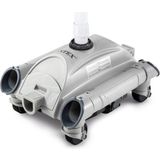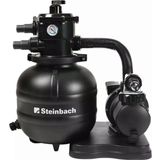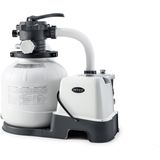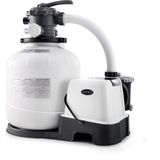Filter Systems - Which one is right for my pool?
There is no one-size-fits-all answer to this question, as both the demands and the requirements can vary greatly. In this article we will find out together how to find the right sand filter for your pool.
The bare minimum a sand filter should do
A sand filter system can perform a variety of tasks - the most important is removing impurities and suspended particulate matter from the pool water. This serves to make your pool look nicer and also collects a variety of organic matter in a dark area where chlorine can function efficiently.
Other functions and tasks of a filter system:
In addition to the above, there are other tasks that your sand filter can take on:
- Keep the water moving (this reduces the reproduction rate of microorganisms significantly)
- Remove filtered dirt permanently from the pool by backwashing
- Circulate the water for effective filtration
- Operate pool accessories such as the Intex Deluxe Cleaning Set and the Intex Auto Cleaner pool robot.
- Pump water over significant height differences (e.g. if pool solar heaters are placed higher)
- ensure effective flocculation
Filtration performance and pool size: quantity vs. quality
You often hear statements such as: "A filter pump should be really strong" from friends, acquaintances or on the internet. Unfortunately, this is too simplistic and not enough to achieve the best results. What's undisputed is that your sand filter should be able to go through the entire pool water once every 5 hours at the latest. For example, your swimming pool has a capacity of 20,000 litres. Your sand filter has to filter at least 4,000 liters per hour in order to completely filter this pool in five hours at the latest.
Sand filters work more effectively with larger tanks
It is essential to understand that the pumping power of your sand filter system is only one factor in good filtration. Equally important is to capture as much dirt as possible in the filter tank and keep it there permanently. Water should flow through the filter tank rather slowly so that small dirt particles are not pushed through your filter medium such as filter sand or glass to end up back in the pool.
Theory and practice: the problem of manufacturers and retailers
That's easy to say, but hard to do. Unfortunately, more than 90-95% of pool owners prioritise throughput. Few rate the tank as important as just the pump performance. What have the manufacturers done as a result? They often construct particularly strong sand filters with tanks that are too small. Simply because potential customers see no added value in investing more money in a sand filter system that has a large tank. But that's exactly where this guide wil help: We strongly recommend that you pay attention to the size of the tank and prefer those sand filters from our range that have a very good balance between pump strength and tank size.
The best sand filter for your pool
There are Steinbach sand filter systems as well as Intex sand filter systems which combined a good mix of pump strength and tank size. This greatly improves the overall filtration quality as well as flocculation. Here are some (very simplified!) recommendations:
Net output: 4,000-5,000 litres per hour: tank greater than or equal to 20kg
- Steinbach Speed Clean Classic 310 (20kg tank)
- Bestway sand filter system Flowclear 5.7m³ (= 5.0m³ net) (36kg tank)
Net performance sand filter: 6,000-9,500 litres per hour: tank greater than or equal to 35kg
- Intex sand filter system Krystal Clear 6 m³ with salt water system (35kg)
- Intex sand filter system Krystal Clear 8 m³ with salt water system (55kg)
- Intex sand filter system Krystal Clear 8.0 m³ (35kg)
- Intex sand filter system Krystal Clear 9.2 m³ (55kg)
- Steinbach sand filter system Compact 8 (50kg)
- Bestway sand filter system Flowclear 8.3m³ (= 6.8m³ net) (45kg)
Net output: 9,500 litres and more per hour: tank greater than or equal to 60kg
- Steinbach sand filter system SM 14 (75 kg tank)
- Steinbach sand filter system SM 16 (150 kg tank)
What else your sand filter should be able to do
There might be other criteria that could be useful or important to you. Many pool owners love performance. But don't forget that performance often results in significant electricity costs and more noise. Only opt for high performance if you really need it or if you really enjoy a powerful pump.
When high performance is just right
Sometimes a lot of power can be essential: some accessories need a certain flow rate to function. Solar heaters placed higher in particular are often a reason to choose plenty of power. The Steinbach Comfort 75 sand filter is a good choice if this is the case. This system has an overly strong motor but if the flow rate drops noticeably due to the back pressure of a solar heater placed at a higher leve, then it is just right.
Sand filter equipment: multi-way valve, timer, fineness
Multi-way valve: more is better!
Sand filters that offer 6-7 settings on the multi-way valve are recommended. You don't need most of them very often, but a setting such as "Winter" is definitely useful to relieve the internal rubber seals. This can extend the lifetime of your sand filter system.
Timer for the sand filter: a matter of taste
Some sand filter pumps have built-in timers. You will have to decide whether this is good or bad. Here are the advantages and disadvantages:
- A timer gives you certain options: if these are sufficient for your pool, then that's fine. If not, then it's a disadvantage. Some timers only allow one cycle per day.
- An integrated timer means that there is no extra device that takes up space or needs to be connected
- Good to know: some timers can be deactivated
Filter fineness
Some sand filters allow grain sizes of 0.4-0.8mm for the filter medium. Others specify coarser grain sizes of 0.7-1.25mm. Smaller grain sizes can of course also hold back smaller dirt particles. However, smaller grain sizes also cause more back pressure in the sand filter. However, we would prefer systems that allow the use of 0.4-0.8mm grain size.
Sand filters with filter balls should be evaluated differently!
Since filter balls with a filtration rating of 2.5 micrometers filter much finer and hold small dirt particles much more firmly, higher flow rates in the tank are much less of an issue for them. If you want to improve the filtration quality of your sand filter without making an expensive new purchase - you can consider using Steinbach Filter Balls. Note that sand filters with very high pump capacities compared to the tank benefit greatly from the use of filter balls.
Related products
-
 4.6 (123)
4.6 (123)Intex Auto Pool Cleaner, 1 Piece
-11%- For max. pool size: 975x488 / Ø792 cm
- Suitable for Intex pools
- Suitable for salt water
€ 84,29 € 94,20Delivery by January 24
-
 4.6 (19)
4.6 (19)Steinbach Speed Clean Classic 310 Sand Filter System, 1 Piece
- Filter performance 5.2m³/h
- For pools up to 22m³
- Low energy consumption
€ 184,45Not available at the moment
-
 4.9 (25)
4.9 (25)Intex Sand Filter Pump Krystal Clear 6m³ with Salt Water System, 1 item
-21% Bestseller- Max. pool volume: 32,200 litres
- Circulation capacity: 6,000 L/h | 6 m3/h
- With pre-filter & timer
€ 316,35 € 399,66Delivery by January 24
-
 4.9 (22)
4.9 (22)Intex Sand Filter Pump Krystal Clear 8m³ with Salt Water System, 1 item
-22%- Max. pool volume: 56,800 litres
- Circulation capacity: 8,000 L/h | 8 m3/h
- With pre-filter & timer
€ 326,27 € 419,49Delivery by January 24

